The Chicken Fat Bolete (Suillus americanus) is a relatively unloved edible mushroom. It's easy to identify for beginning foragers and can be collected in quantity. Its flavor and texture make it mediocre at best, but some people claim to like it. Read on and I'll explain what you need to know.
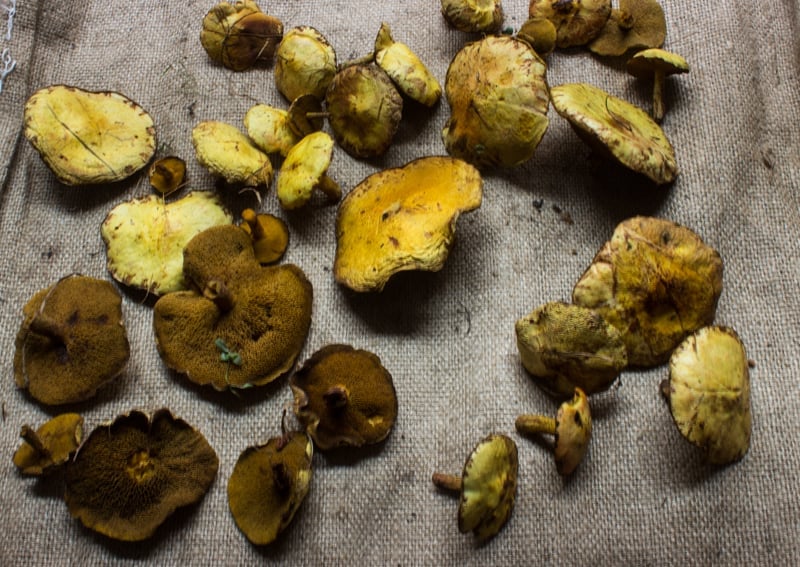
These are a type of slippery jack mushroom, which means they're a bolete (a mushroom that has pores instead of gills). They differ from other boletes in that their cap can be slimy when it's moist outside. The slimy-ness is less apparent when It's dry, and they become a bit tacky to the touch.
What I find special about Slippery jacks is that they're are beloved by people from Eastern Europe. Most American mushroom hunters I know don't care for slippery jacks at all and regard them as a garbage mushroom.
Habitat
I see chicken fat boletes in Minnesota and the surrounding region exclusively with Eastern white pine or other 5-needled pine trees. They hide in the long grass under the pines and it seems to me they like trees younger although I do see them occasionally with older pines too. They'll also grow under western white pine, limber pine, and Siberian pine.
They'll start to fruit typically in August, at the end of the Bolete and Chanterelle season but before the Honey Mushrooms. They grow in large troops, sometimes I will randomly come across twenty or thirty mushrooms while not even looking for them.
Suillus americanus Identification
Suillus americanus has a sticky yellow cap with reddish brown fibers and scales. There may be remnants of a tattered veil on the margin. The yellow pore surface when young has large, angular pores. It has a tough, skinny stem, which can show glandular dots on it.
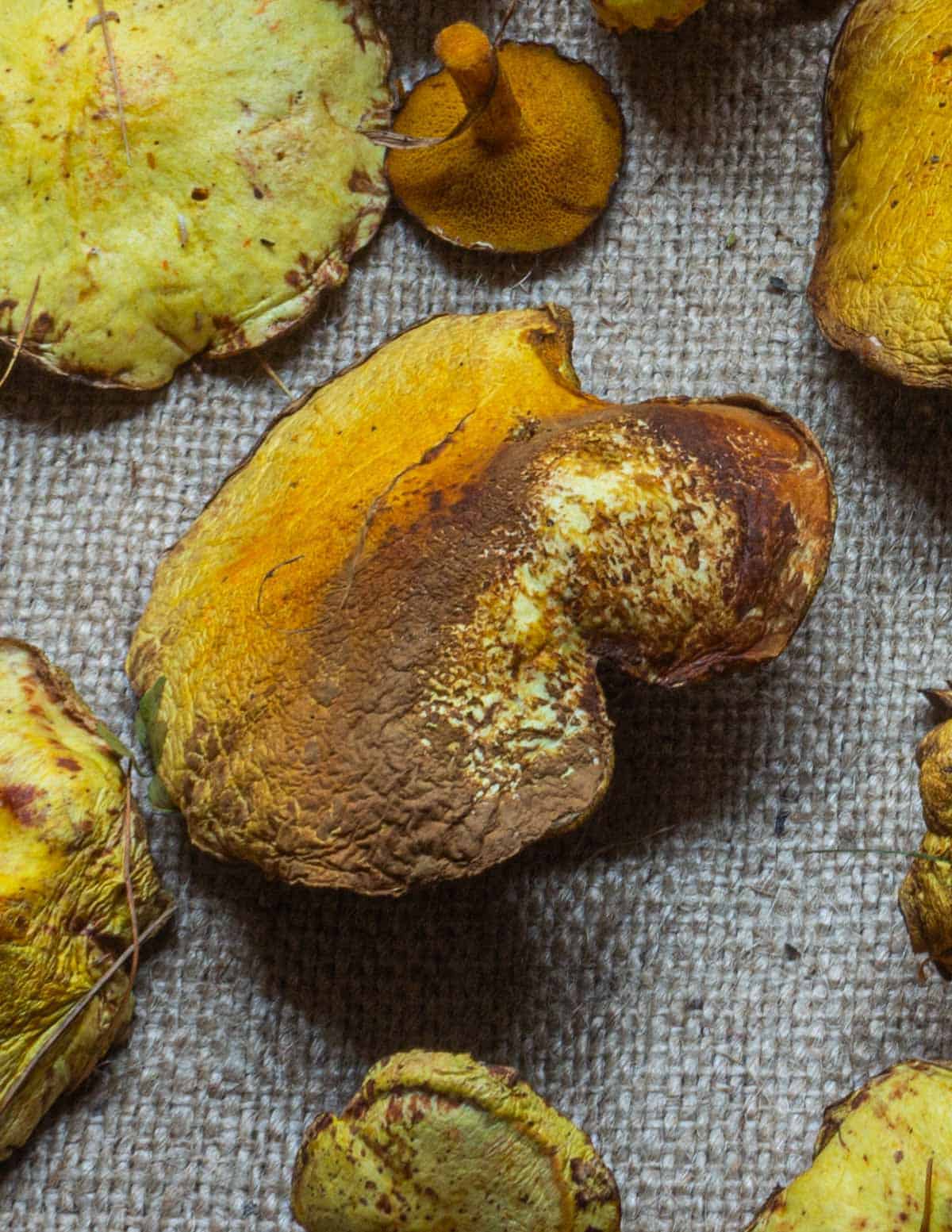
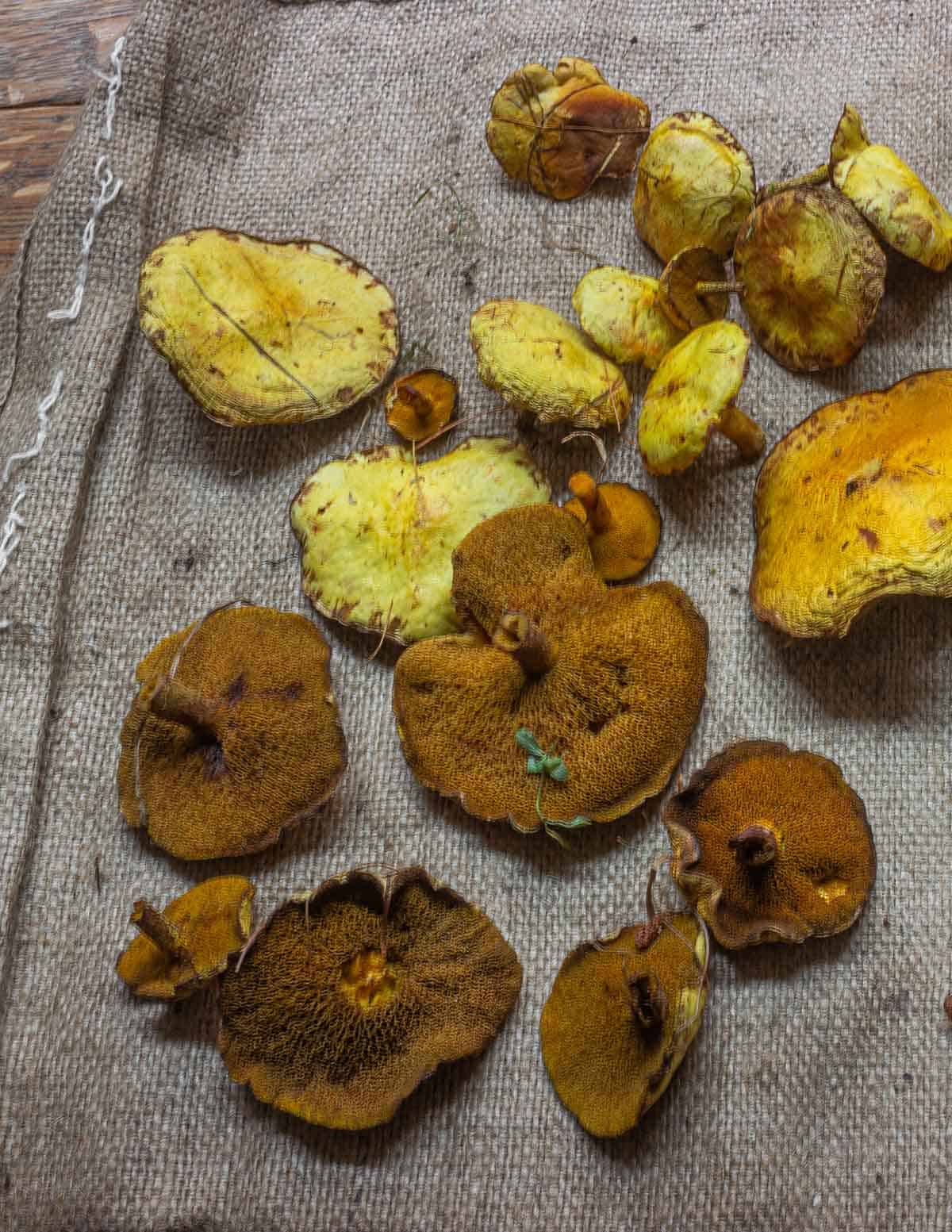
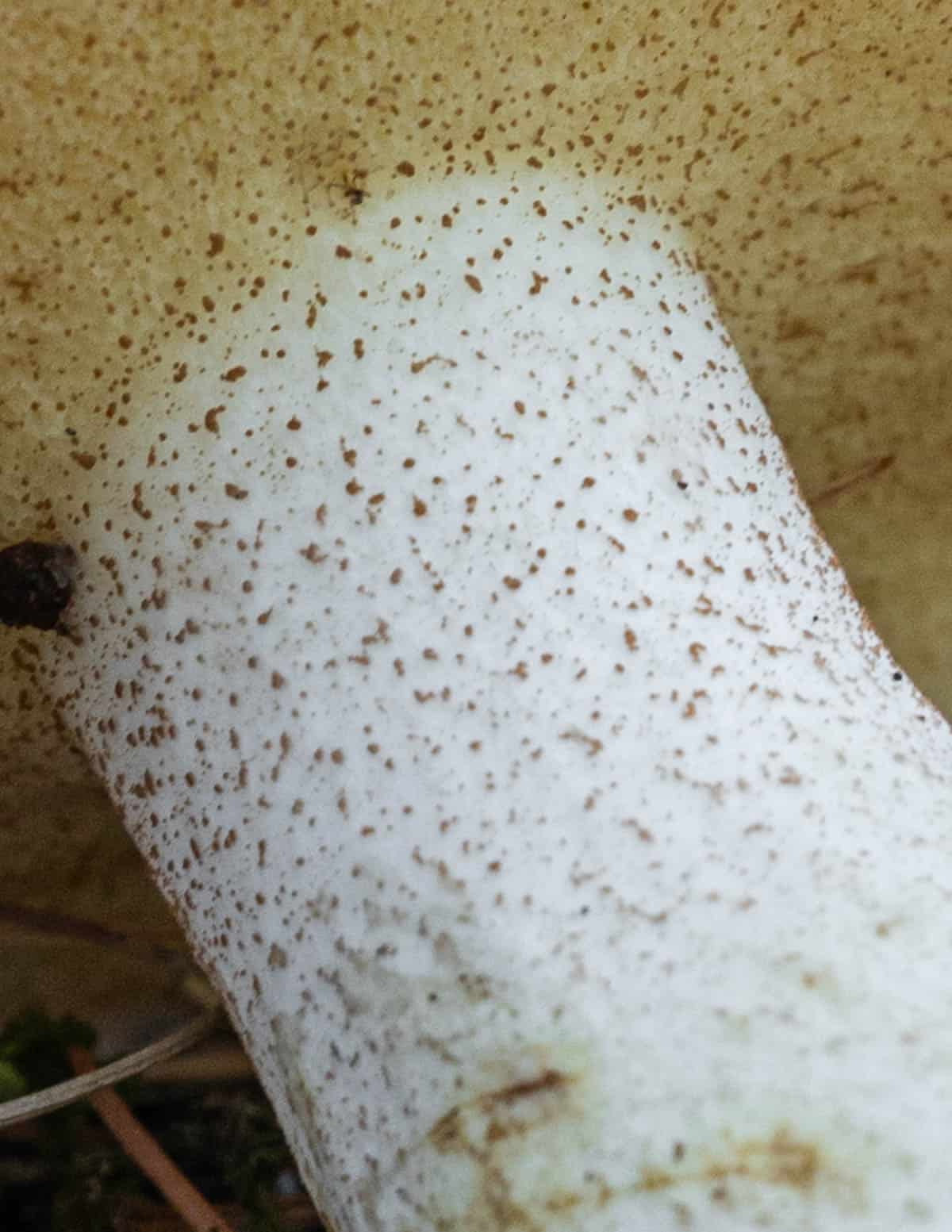
Suillus americanus look alikes
Suillus americanus has a few look alikes. The most likely you'll see are other slippery jacks that grow in five-needled pine forests like Suillus granulatus or Suillus luteus. None are poisonous mushrooms.
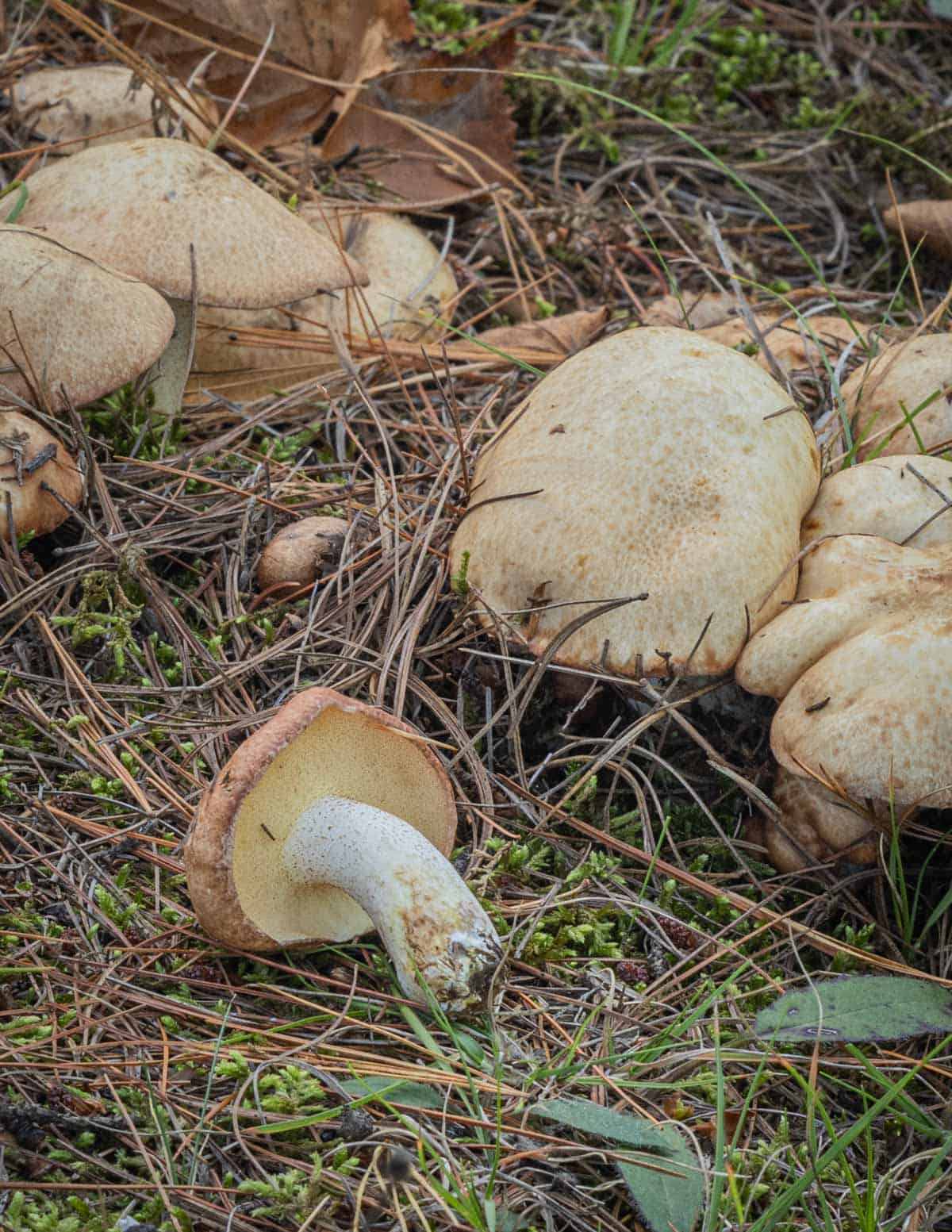
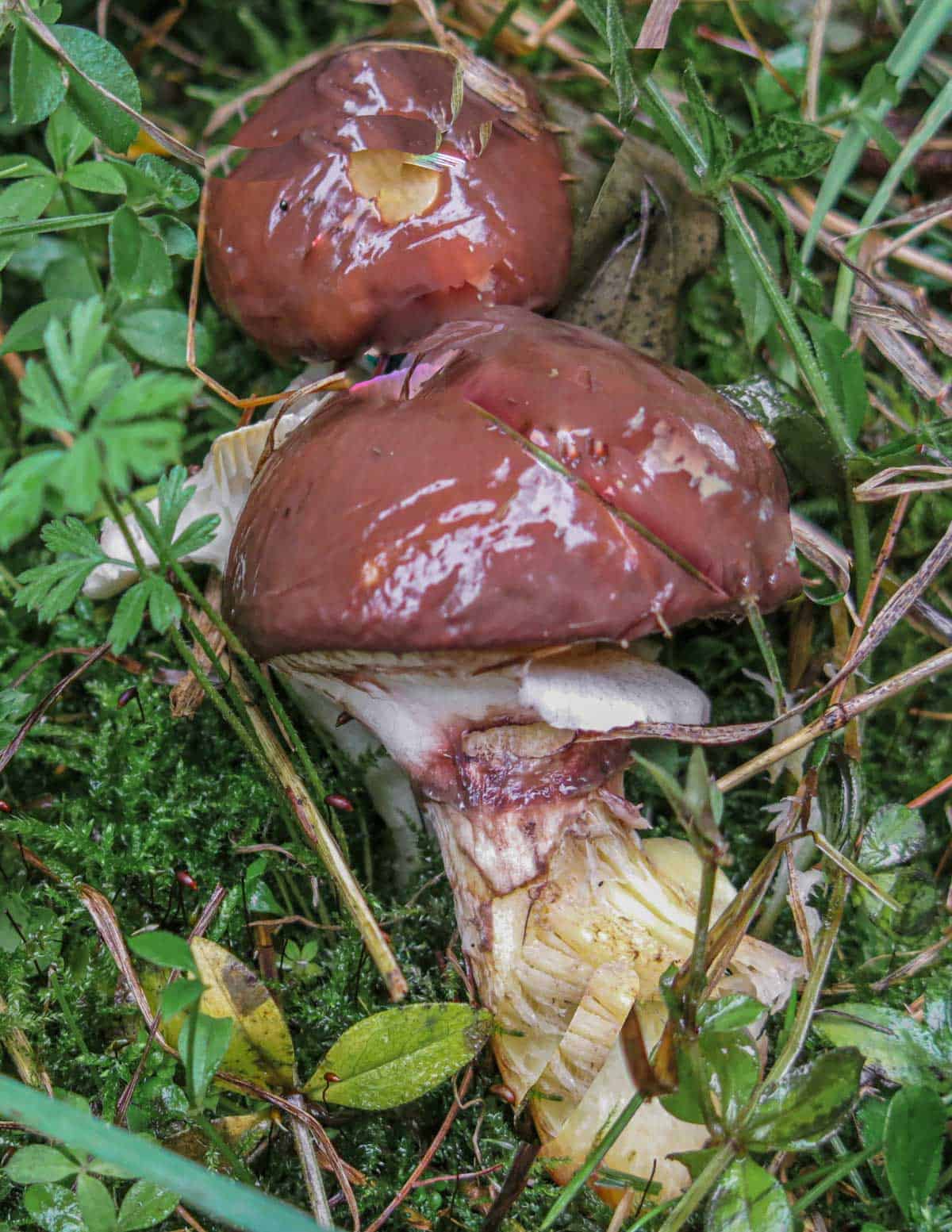
How to Cook Suillus americanus
I don't cook these fresh as the sour taste and texture of the thick brown pores is a deterrent. Fried up in garlic butter, cooked with wine and herbs, stewed in meat stock, whatever I do, the result is the same, they're just not great compared to other mushrooms. Once dried they have a rich woodsy flavor that can be added to mixes of dried mushrooms, in small amounts.
The flavor is very rich and is an acquired taste. Do you like things like liver pate or organ meats with a note of cat urine? If so, you might like these! For the culinary faint of heart, these have an aggressive flavor like organs, so I like to mix them with other boletes like Leccinums or porcini, if I cook them at all. Best to mince them or cut into small pieces.
Dried and ground to a powder is probably the best thing to make with chicken fat boletes. Mixed with coffee and spices I've actually liked a rub made with them used to season pork tenderloin.
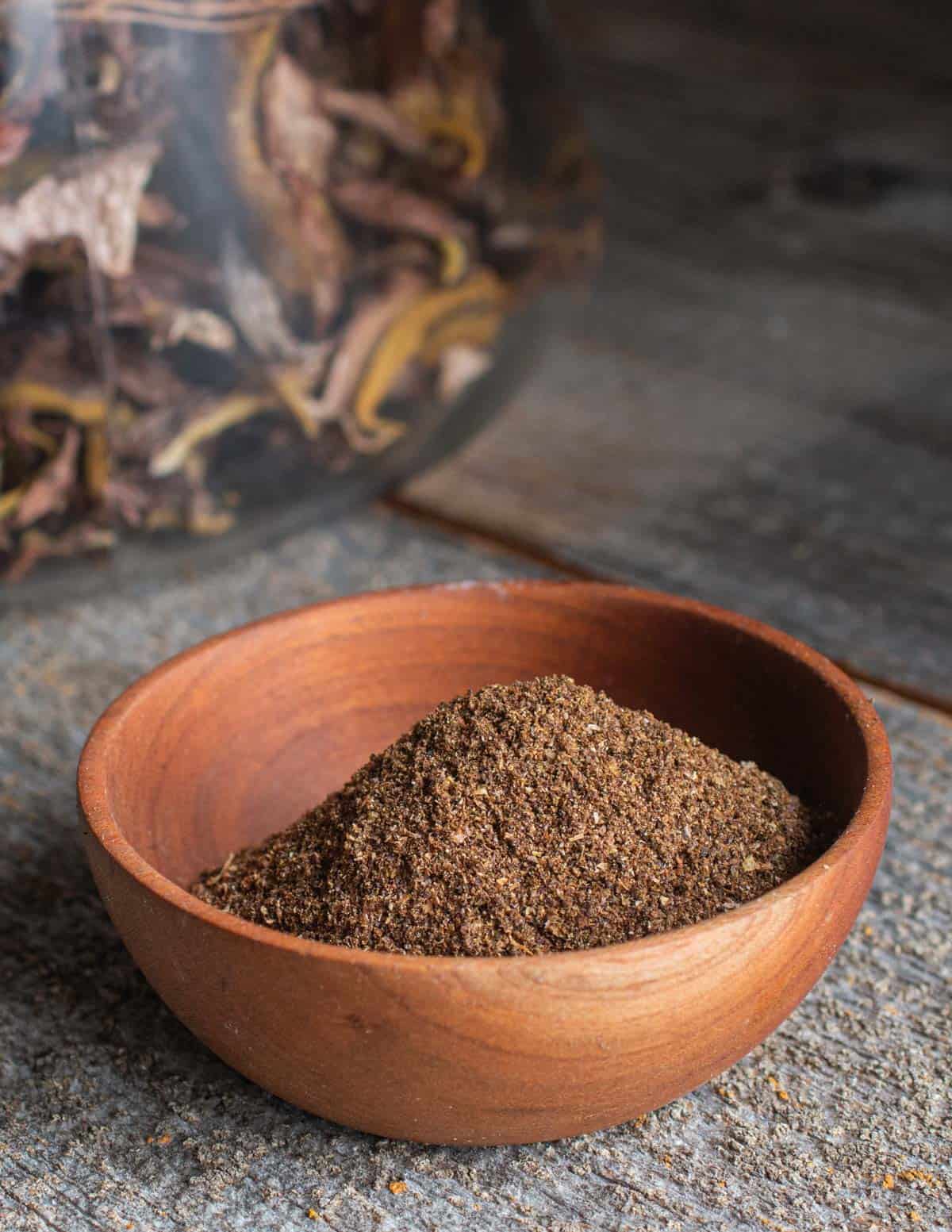
Preservation
If you have a dehydrator, slice the mushrooms thinly, discarding the stems, and then place them in the dehydrator at 100 F for 24 hours. If your dehydrator has metal drying racks, you'll want to spray them with some nonstick spray, since these guys have a tendency to stick (alternately place the thinly sliced mushrooms on parchment) then dry on the lowest setting of your dehydrator.
You'll want to do this immediately the day you pick them, otherwise they will turn to a pile of slime in your fridge, bolete mushrooms have a short shelf life, although these are better than porcini.
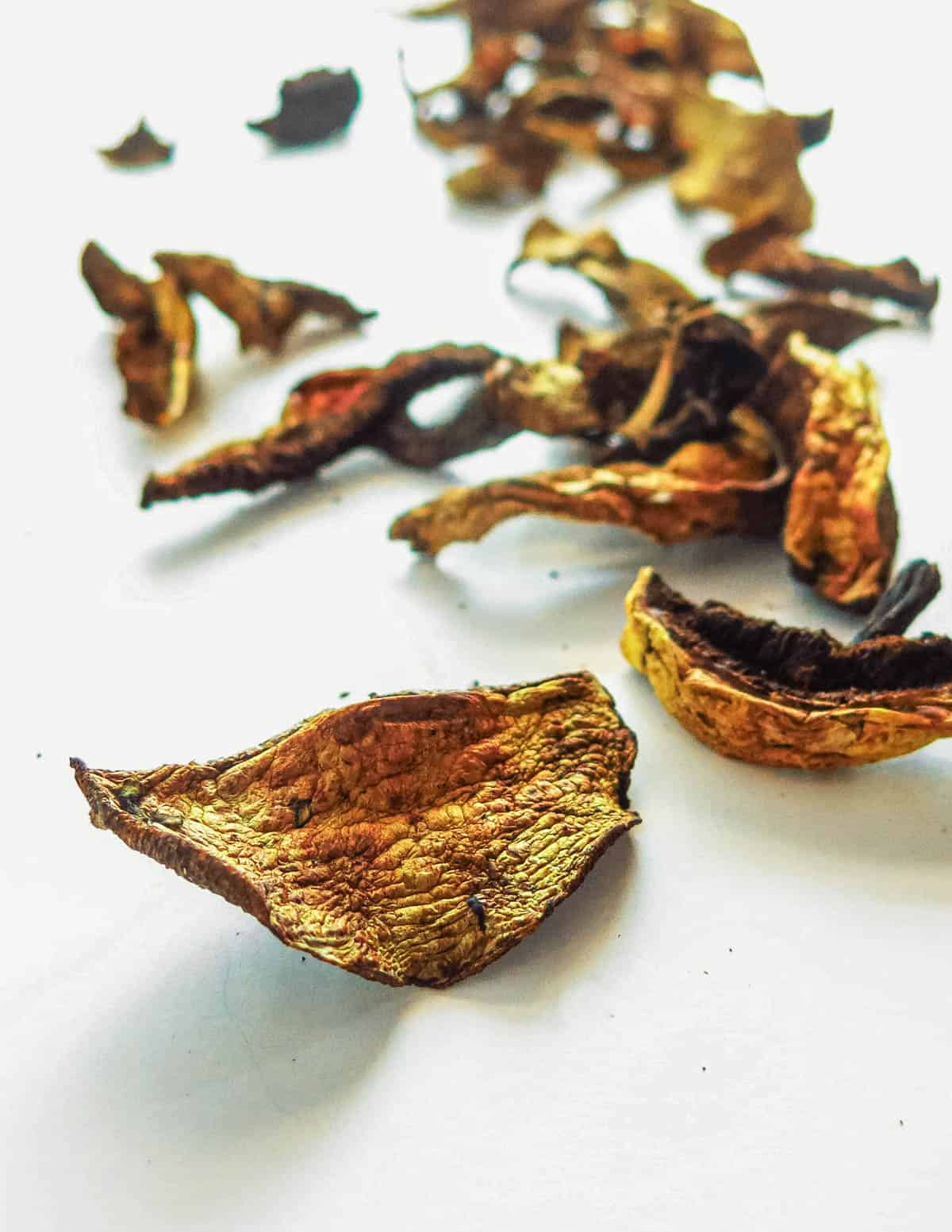
When they're cracker dry, store the mushrooms in a sealed container like a glass mason jar and they will keep for a very long time.
When you want to re-hydrate chicken fat boletes to use, remember to pick out the little blades of grass that will stick to their cap, soaking in water will release these, and they will float to the surface of whatever liquid you are re-hydrating them in. Simply pick the grass out, then pick out the mushrooms, strain the liquid, and then combine the liquid and the reserved mushrooms to add to whatever dish you're creating.
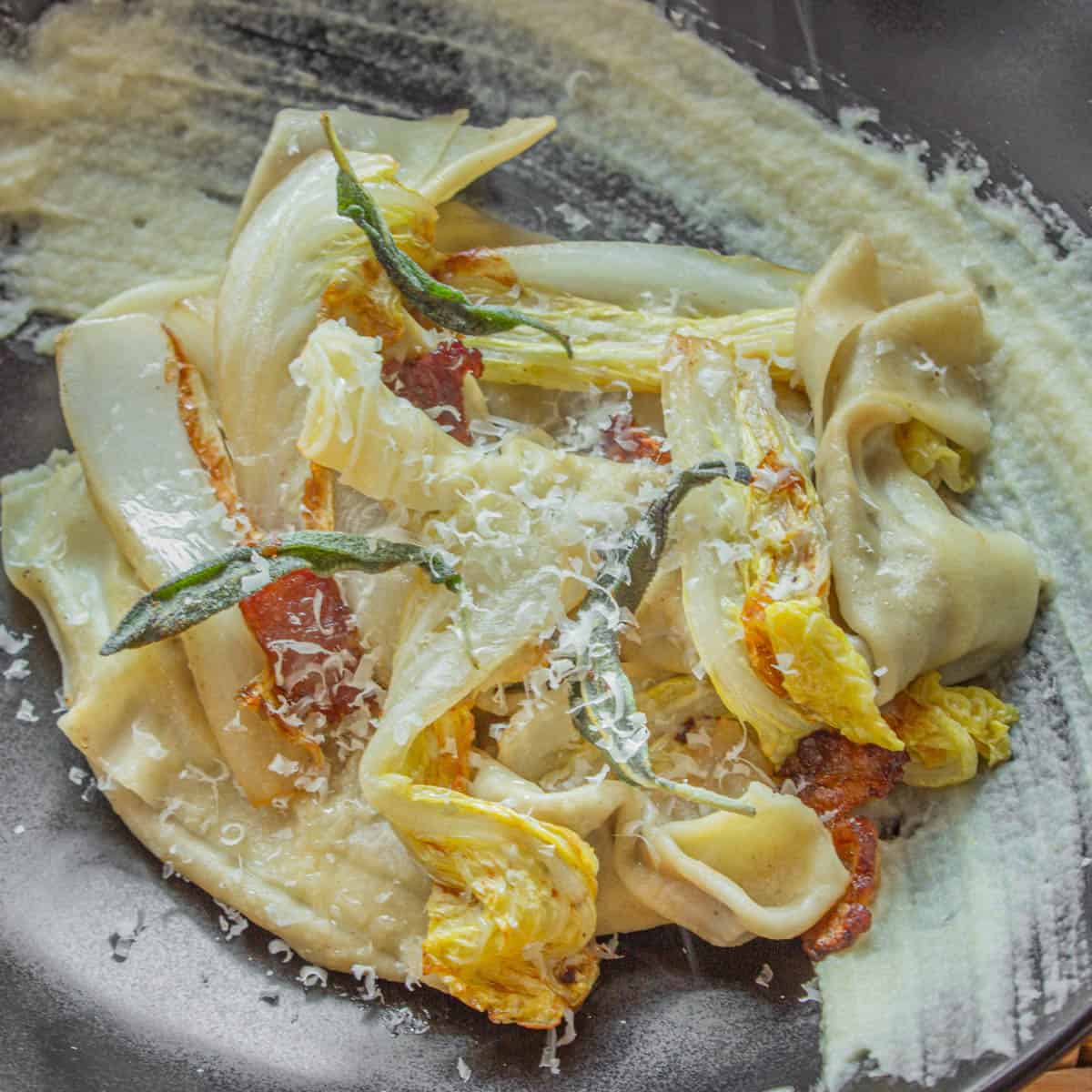
Recipes
Here's some favorite recipes I like specifically for Suillus, or boletes in general.

Priya
I forgot to add: I would not have thought to use them in this way without this post, Alan. I saw "organ meats" and "cat urine" and knew what to try. I rarely end up making your recipes exactly, but when I encounter a wild food that's new to me, I always use your ideas and notes as jumping-off points for what *I* want to eat and what flavors I want in my life. Your blog is invaluable, and I'm grateful for it! Thank you.
Alan Bergo
Thanks so much for commenting. Just as a lot of people find my work useful as a starting point, comments like yours help me fill in gaps and nudge me to reconsider things from different angles. I’m definitely going to try them with beans, thank you!
Priya
Just wanted to put in a good word for powdered chicken fat mushrooms cooked with big dried beans (like ayocote pintos or scarlet runners) in a Mexican style. I cannot get over how iron-y these mushrooms smell when you pick them and dry them -- like liver or other organ meats I guess, a little freaky -- but that same quality adds gravitas to veg preparations. As a vegetarian who always wants more savory depth and umami, I'm a fan.
Cristina
I know this is an old post, but have you tried peeling off the skin of the cap and separating the tube section of pores? I am told they taste much better that way overall, and that the preferred part is just the remaining mushroom “meat” of the interior.
Alan Bergo
HI Christina. I haven't. There's so many better mushrooms, including a few slippery jacks that I usually pass these by.
Dunori
I dried some of these a few years ago and threw them into some egusi stew while on a camping trip; my fellow campers from then have been near harassing me ever since to make it again because they liked the mushrooms sooooo much. I just found some more yesterday so I will soon be able to appease them. Thanks for the additional methods for preparing it bro and your website is awesome!
Alan Bergo
Egusi stew! Not a lot of people would make that on a camping trip. I actually just bought some egusi for a project I'm working on with a lamb and goat farm. Great traditional food there, and thanks.
abi
can you list the edible mushrooms that are found on ash trees should there be any if you knowledgeable of
Alan Bergo
Refer to Boletinellus merulioides.
Emi ray
Please give me tips as I am new to this hobby I found a ton of these growing in my yard I have no dehydrator
Emily ray
I am new to mushrooming I live in Michigan and found these growing in my back yard I have never picked any wild mushrooms nor do I have a dehydrator so how would you recommend me taking care of these babies I guess cut them all up in smaller pieces and lay them out in front of a fan ids my best bet please give me all the tips to make these mushrooms I am so excited to try this
Alan Bergo
Find a way to dehydrate them, set them in a low oven, etc.
Bob Pflug
I usually pick white pine boletes in the autumn here along the Ottawa River but not many. I just found enough to fill a 5l pail and will dry them. We have a GE convection oven which keeps quite warm with the door agar slightly and the light on. Of course the there will be no convection so I will substitute an old computer fan.
Johnna Funk
Time is of the essence!
Johnna Funk
Do you cut up all of the mushroom, stem included, or just the cap when drying out? I've got a ton of her growing in my yard under white pines through out the year excluding winter. I'd like to dry some right now so I can try your recipe in a few days. We always have an abundance of it and a new batch is up now that I don't want to waste.
Alan Bergo
Cut it all up.
Jay C. White Cloud
Hi Alan,
Just found your site...Great Post!!!
However...!!!...you are giving away some great secrets!!!...ha, ha.
Suillus are one of the unsung heros of the mushroom world, and this post reflects that. They are simply a delicious mushroom if one has been taught (or learned) how to prepare and use them. Of those of use raised Wild Harvesting this is one of the...go to...mushrooms as they are so plentiful in their season...and most do (or have) passed these over as...not good to eat. The enzymes in fresh specimens can cause severe indigestion in many folks, but I also find that the...modern stomach...a very weak and sensitive thing in most Westerners. The edible members of this Genus I find strengthens digestion if one has built up their pallet and system to Wild Foods and a much more robust Paleo Diet. I offer that as encouragement, yet also a warning that Wild Foods are something to move slow with in adding to a diet not use to them...
Regards,
j
Alan Bergo
Hi J, and you're totally right. My friends from Russia and Eastern Europe especially love all species of Suillus. From my experience, most people in America have been conditioned to like other more well known mushrooms, which means more Suillus for you. How do you like to eat them?
Alexandre Beaudet
I just sauteed a batch in plain oil side by side with blueing bolete and honestly... the suillus americanus has a lot more kick to it than blueing. Yough specimen have a nice texture. They have a nice tang and a nice citrus flavor that lasts, I would definetly serve them fresh and cooked with fish, wild rice or mixted with lobster mushroom! But it's true that their flavor might be a bit off to people who seeks a more general bolete flavor.
Alan Bergo
Their flavor is a bit stronger, but I don't mind them especially if they're prepared in a blend. They get a very rich after drying too. Good for you for doing some taste testing, there are so many differences between species that's worth comparing and contrasting.
Van
My Father strung Suillus by string, with stems, hours of work, total failure...in the 60's. Never forayed them again. Now, I'm old.. stayed away because of always peeling cap skin from literature. Now, no stem.. slice ...dehydrate..sounds easy. I will try. Thanks. Suggust any fantastico Bolete guide books with Amazing color pictures Bessette's which I will order?
Alan Bergo
Bessette's North American boletes is as good as you will get. Chicken fat boletes will dry like a dream in a dehydrator.
Van
My Father strung Suillus by string, with stems, hours of work, total failure...in the 60's. Never forayed them again. Now, Imold.. stayed away because of always peeling cap skin from literature. Now, no stem.. slice ...dehydrate..sounds easy. I will try. Thanks. Suggust any fantastico Bolete guide books with Amazing color pictures Bessette's which I will order?
Lori
A question about dehydrating these. I have a decidedly low tech cabin that has tons of these growing in the surrounding woods. I don't generally bother with them because, until your article, I have not found the descriptions of them as an edible compelling. Anyway, I would like to dry them partially at the cabin and then bring them back to finish off in the dehydrator I have in my city home. Any thoughts or advice?
Alan Bergo
I would cut them into thin slices and and place them on screens or something that allows air to circulate around them. It will help a lot if you have a fan of some sort or a breeze. Stringing them up on a line after they're sliced would be time consuming, but would also work.
John Tummon
White Pine Boletes are not Slippery Jacks IMO. I've dried a lot of mushrooms at my hunt camp with an old window screen suspended over the wood stove
Alan Bergo
They may not be exactly the same as other slippery jacks, but for culinary purposes(the subject of this website) their flavor is very similar, that's why I refer to them as such.
Chris Seifried
My Polish grandmother and mother always reminded me that with Suillus (maslaki) you must always remove the thin slimy membrane that covers the cap to avoid indigestion. Have you heard anything like that?
Alan Bergo
Hi Chris, yes I have definitely heard and felt the indigestion that is possible from slippery jacks. It is ONLY from ingesting them fresh from my experience, and was quite mild. This, and their very short shelf life is why I dry all slippery jacks immediately to preserve them. Slippery jacks are among the most under represented mushrooms in my opinion, but people like your grandmother know they are special. With the chicken fat bolete in particular, peeling the cap would not be possible, since they are so small. Other slippery jacks and similar mushrooms I like to peel though, such as leather veiled boletes.